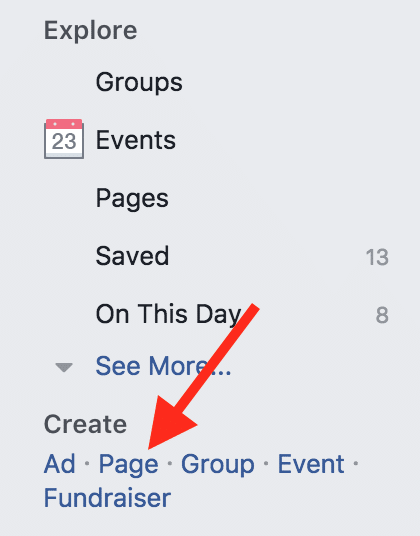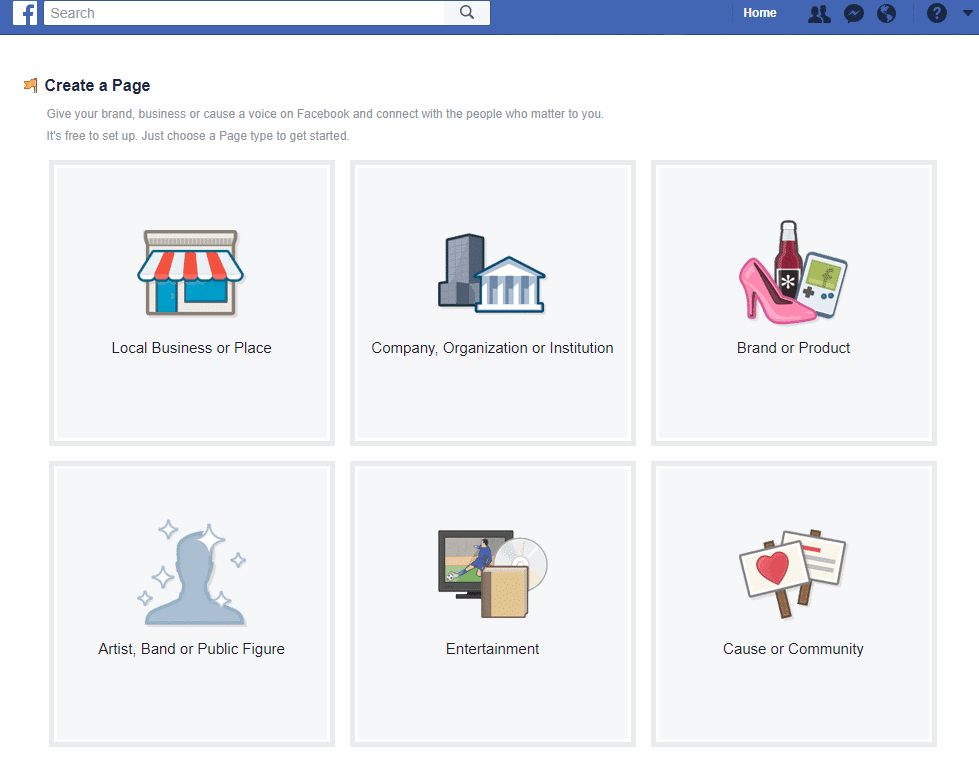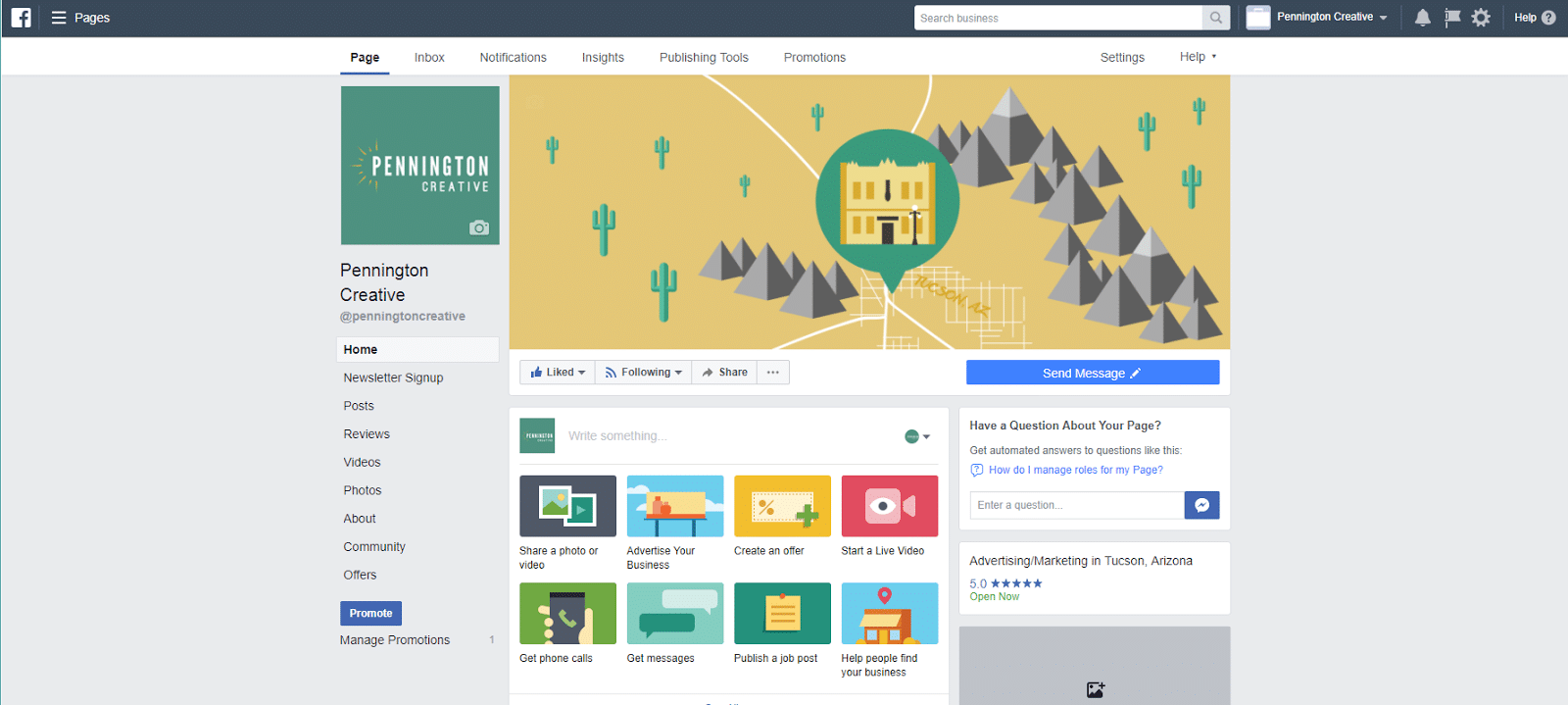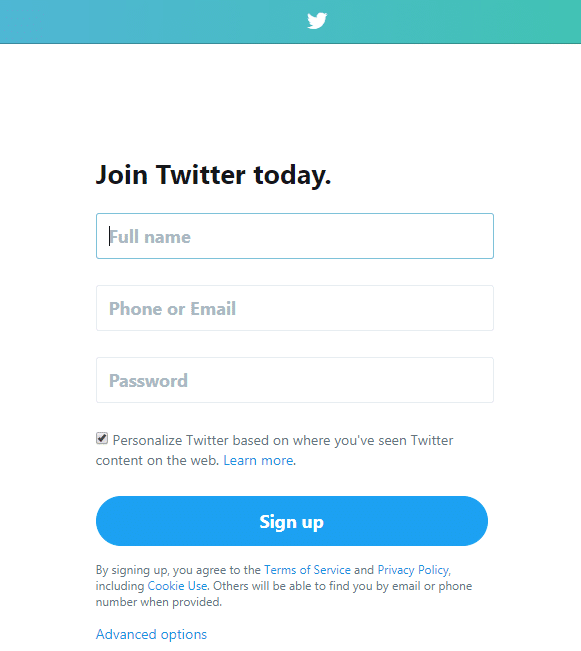Social media has become a big part of our daily lives. Whether you use Facebook to stay in touch with friends and family or look to Instagram for style inspiration, you likely use at least a couple of social media platforms—but are you using them for your business? Social media marketing can offer many benefits, including helping your brand build a better online reputation and helping you connect with more potential customers. If you haven’t created pages for your business yet and need a little help, keep reading! I’ll walk you through the basic steps you’ll need to take to get your business started on some of the most popular social media platforms.
Did you know that Facebook has over 1.3 billion daily active users on average? That makes this the most popular social media platform in the world. Since it seems like pretty much everyone uses Facebook, why not take advantage of having such a large audience at your fingertips by creating a business page? Despite recent updates regarding organic reach for businesses on Facebook, it’s still a key way for people to find and interact with your business. So, let’s get started:
You’ll need a personal Facebook profile to create a page for your business. From your homepage, click on the “Pages” tab located under “Explore” on the left hand side.
Next, you’ll click on the green “Create Page” button in the top right corner. From here, you’ll need to choose the appropriate type for your page from the following options:
- Local Business or Place
- Company, Organization, or Institution
- Brand or Product
- Artist, Band, or Public Figure
- Entertainment
- Cause or Community
You can click on each option to learn more details and figure out which one is right for your business. You will most likely select the “Company, Organization, or Institution” option for your business, and then you’ll be prompted to select the most appropriate category for your business. Next, you’ll need to enter the name for your business page. It is best to stick to your business’ name for this page to keep your brand consistent.
Now that you’ve created your business page, you’ll want to fill out the basic information about your company. Fill out the “About” section with a couple of sentences to describe your company. Include a link to your website so Facebook users can easily find your website instead of trying to look for it on their own. After this, you should upload a profile picture and cover photo. Your profile picture will represent your brand, so it’s important to choose an image that is eye-catching, easy to read, and memorable. The image you choose should be professional while also representing what makes your brand unique or what gives it voice or personality. If you want the focus to be on your brand, consider using your logo as your profile picture. If you’d rather have one person associated with your brand, then you might want to use a high-quality picture of that person. Avoid choosing a profile picture that has too much text or is hard to read.
Always use a high-quality picture so that it looks clear and crisp on your profile. Your cover photo is located at the top of your profile and can also be used to represent your brand or call attention to a special promotion or upcoming event. (I share links to image requirements later on in this post).
When you’ve filled out all of the necessary information and have uploaded your pictures, you can publish your page to make it visible to all Facebook users. Start posting content as soon as possible so that your page will be engaging and attractive to Facebook users. Encourage all employees to Like your company’s new Facebook page so you can start building a fanbase. Include a link to your Facebook page on your website and in your email address so customers and colleagues can easily find and Like your page.
I’ve found that Facebook is a great platform for publishing your scheduled posts and reaching out to potential customers and other businesses located near you. It also offers a wide variety of advertising capabilities, which will let you show off your products and services, highlight upcoming events, or simply encourage more people to like your page.
- What to Post:
- Videos
- Photos
- Links
- Short stories/messages
At the end of 2017, Twitter had approximately 330 million monthly active users, making it one of the most popular social media platforms. This platform first stood out from other types of social media because it only allowed users to post 140 characters at a time, though that number increased to 280 characters in November of 2017. Twitter users love to communicate with brands here, and unlike users on other platforms, Twitter users typically don’t mind seeing multiple posts from the same brands or accounts in one day.
Unlike Facebook, Twitter business accounts are just like any other account, so you don’t need a personal profile to make and manage a business page. To create your account, you’ll need to come up with a username and password. Your username can only be 15 characters long. Use your business name as your username if possible, if not, come up with something simple and easy to read that represents your brand. You will also need to choose an email account to associate with your Twitter account, so consider using a company social media email account instead of a personal one. You will be able to change your username in the future, so don’t worry if you can’t come up with the perfect name right now.
Once you’ve created an account, you should fill out the bio section. Your bio can be up to 160 characters long and should describe what your business is and what you offer. It’s also important to include a link to your business website in this section. Next, you’ll need to upload a profile picture and header image. Your profile picture should be attractive and easy to read or distinguish in a small size. This picture will be next to every Tweet you post. Your header image is located at the top of your profile page and can enhance the overall aesthetic of your profile or highlight a seasonal special. Check your profile and header images on both desktop and mobile to make sure they look great on any device.
Now it’s time to start posting! Don’t be shy—like I said, Twitter users love engaging with others on here, and posting 5-10 times a day (or more!) isn’t unheard of. You can Tweet images, videos, and links to blog posts and other content on your website. Start following accounts that are relevant to your industry (you can find accounts by searching for hashtags that relate to your business). Interact with other Twitter users by liking or replying to their Tweets so that other users are more likely to start following your account. Just like with your Facebook profile, you should add a link to your Twitter profile on your website and in your email signature.
From my experience, Twitter is definitely a less formal place than Facebook, so it’s okay to try more creative and random posts on this platform. Most of the content you post should be relevant to your industry, but it’s also okay to post jokes, GIFs, and other fun stuff that will help you brand stand out from the competition.
- What to Post:
- Links
- Videos
- Photos
- GIFs
- Questions
- Polls
LinkedIn is a unique social media platform that focuses more on business than personal relationships. This website has 467 million users, and can help enhance your company’s online reputation while also providing an extra space where potential customers can find you and learn about your business.
To create a LinkedIn page for your company, you’ll first need a personal profile. Once you’ve created your profile, you can click on the “Work” icon and then click “Create a Company Page.” You’ll be prompted to choose a name for your business page as well as a URL. Your name should be the name of your company, even if there are other businesses or associations with the same or similar name. Your URL needs to be unique, however, so choose something that represents your brand if your name isn’t an available option. Next, LinkedIn will prompt you to check a verification box as proof that you have the right to create this page on behalf of your company. Finally, click on the “Create Page” button to publish your page. Encourage your employees to join LinkedIn if they haven’t already and ask them to start following the company’s page. Add a link to the company LinkedIn page to your website and your email signature. You should also promote this new page on your other social media profiles so any fans and followers you already have are aware that you’re now on LinkedIn.
Since LinkedIn is a platform for professionals, it’s better to stick to more formal and relevant posts on this platform. People don’t necessarily turn to LinkedIn to find the latest news—a lot of users are just trying to connect with colleagues or look for new job opportunities—so don’t feel pressured to post too often.
- What to Post:
- Links to your website
- Blogs
- Links to articles relating to your industry
Instagram has become one of the most popular social media platforms over the last few years, with 800 million monthly active users as of September, 2017. Unlike other networks that let you post many different types of content, Instagram focuses on pictures and videos. This is what makes Instagram a great marketing tool, whether you’re selling graphic design services, unique products, or your own personal brand.
To create a business Instagram account, you’ll need to download the Instagram app onto a smartphone or other mobile device. You’ll be able to look at your Instagram profile and other profiles on your laptop, but you can only post photos from mobile devices. Next, you’ll be prompted to create an account by first entering your email address or by signing in with a specific Facebook account.
Once you’ve created an account, you can click on the “Settings” button and select “Switch to Business Account” to specify that your new account is for a company, not an individual. Now that you have an official business profile, you should add bio information that will help guide people to your website. Include your company name, URL, and a brief description of what you do. Now you’re ready to start following people, posting pictures, and encouraging your customers to follow your account. Again, it’s a good idea to include a link to your Instagram profile on your website and in your email signature.
Instagram is all about having fun and showing it off with pictures and videos. If you have physical products, then you can take pictures of them and use Instagram to promote these items. If your business offers services that can’t necessarily be photographed (like us!), then use Instagram as a way to show your brand’s personality.
- What to Post:
- Product pictures (if you have them)
- Video demonstrations of products (if you have them)
- Pictures of employees
- Pictures of your office/building
- Pictures of events around town
- Decide what platforms you should be on
- Facebook, Twitter, Instagram, LinkedIn—these are some of the most popular, but your brand doesn’t have to be on every platform
- It’s better to choose a few that you can really commit to instead of trying to post to all platforms regularly
- Facebook and Twitter are good starting points
- Create your profiles
- Come up with your profile/account names
- Try to make it your company name if possible
- If not, make it something close or something memorable–make it easy to type and make sure it represents your brand
- Try shortening your brand name
- Example: Moz founder Rand Fishkin’s Twitter handle is @randfish
- Add an action verb like “try” or “use”
- Example: Publishing platform Ghost’s Twitter handle is @TryGhost
- Use your URL
- Example: Ask.com’s Twitter handle is @AskDotCom
- Try shortening your brand name
- You can use this website to see if names are available on different platforms: https://www.namecheckr.com/
- Fill out all information
- Use high-quality profile and banner photos
- These links will come in handy when you’re ready to create your profile on these platforms:
- Link to your website
- Come up with your profile/account names
- Identify your goals
- Social media can offer many different benefits for many different businesses
- Identifying your goals can help you determine what you want to post on social media, how often you’ll post, and how you can use advertising to your advantage
- Some goals you might want to consider for your business include:
- Increasing brand awareness
- How many followers/fans do you have?
- How many people see your posts?
- How many shares/likes/Retweets do your posts get?
- Driving people to your website
- How many people find your site from social media?
- How much time do people from social media spend on your website?
- How many people from social media become customers?
- Generating new leads
- How many people have given you personal information through social media?
- How many people participated in your social media contest?
- How many of these leads turned into real customers?
- Increasing sales
- How many sales have you made through social media advertising?
- Increasing brand awareness
- Create posting schedules
- Decide how often you’re going to post and what you’re going to post
- It’s important to stay active on all platforms you use
- It’s a good idea to check on fan/follower insights to find out when your fans and followers are most active on each platform
- This will help you figure out when to post
- Here’s a look at what I’ve found works best:
- Facebook: 1-2 times per day
- Facebook users might feel bombarded if they see more than 2 posts from you each day
- Twitter: Up to 5 (or more!) times per day
- Twitter feeds are constantly updating with the latest posts, so your followers will be cool with seeing more updates from your brand
- LinkedIn: 1-2 times per week
- LinkedIn is a business-oriented platform, so it’s important to keep things professional and avoid overdoing it with updates that might not be totally relevant to what your followers want to see
- Instagram: 1-2 times per day
- Instagram feeds are constantly updating, so your followers won’t mind seeing 1 or 2 pictures from your brand each day
- Facebook: 1-2 times per day
Now that you’ve read about the basics, it’s time to get started! Tackling a social media marketing strategy on your own can be difficult and overwhelming, especially when you’re just getting started. That’s why you can rely on the social media marketing services provided by Pennington Creative. Our team can help you make the most of your social pages while also creating custom and engaging content for you to post regularly. Check out the rest of our website for more information and to find blogs, infographics, and downloadable content to help you take advantage of everything social media marketing can offer your business!
Further reading from Pennington Creative:
Check out this downloadable guide for more tips that can help your business learn how to post regularly on Twitter and Facebook.
This blog can help you create a social media strategy for your brand: https://penningtoncreative.com/business-social-media-strategy/
Every brand needs its own social media voice! Learn how to create yours: https://penningtoncreative.com/social-media-voice/
Social media trends are constantly changing. We help you learn about the most anticipated trends for 2018: https://penningtoncreative.com/social-media-trends-2018/
Get inspired by taking a look at the major changes Facebook has experienced since its beginning in 2004: https://penningtoncreative.com/facebooks-changes-since-2004/
Make the most of your brand’s Facebook page by using the features highlighted here: https://penningtoncreative.com/social-media-features-facebook/
How did Twitter get started? Find out: https://penningtoncreative.com/the-origins-of-twitter/
Twitter offers many features that can help your business, like the ones we go over here: https://penningtoncreative.com/social-media-features-twitter/
What can your brand do on Instagram? We cover some of the most useful features: https://penningtoncreative.com/social-media-features-instagram/
Take a look at this blog for tips that can help you better incorporate LinkedIn into your marketing strategy: https://penningtoncreative.com/linkedin-marketing-plan/
Wondering what other social media platforms your business can use? Check this out: https://penningtoncreative.com/social-media-features-other/









